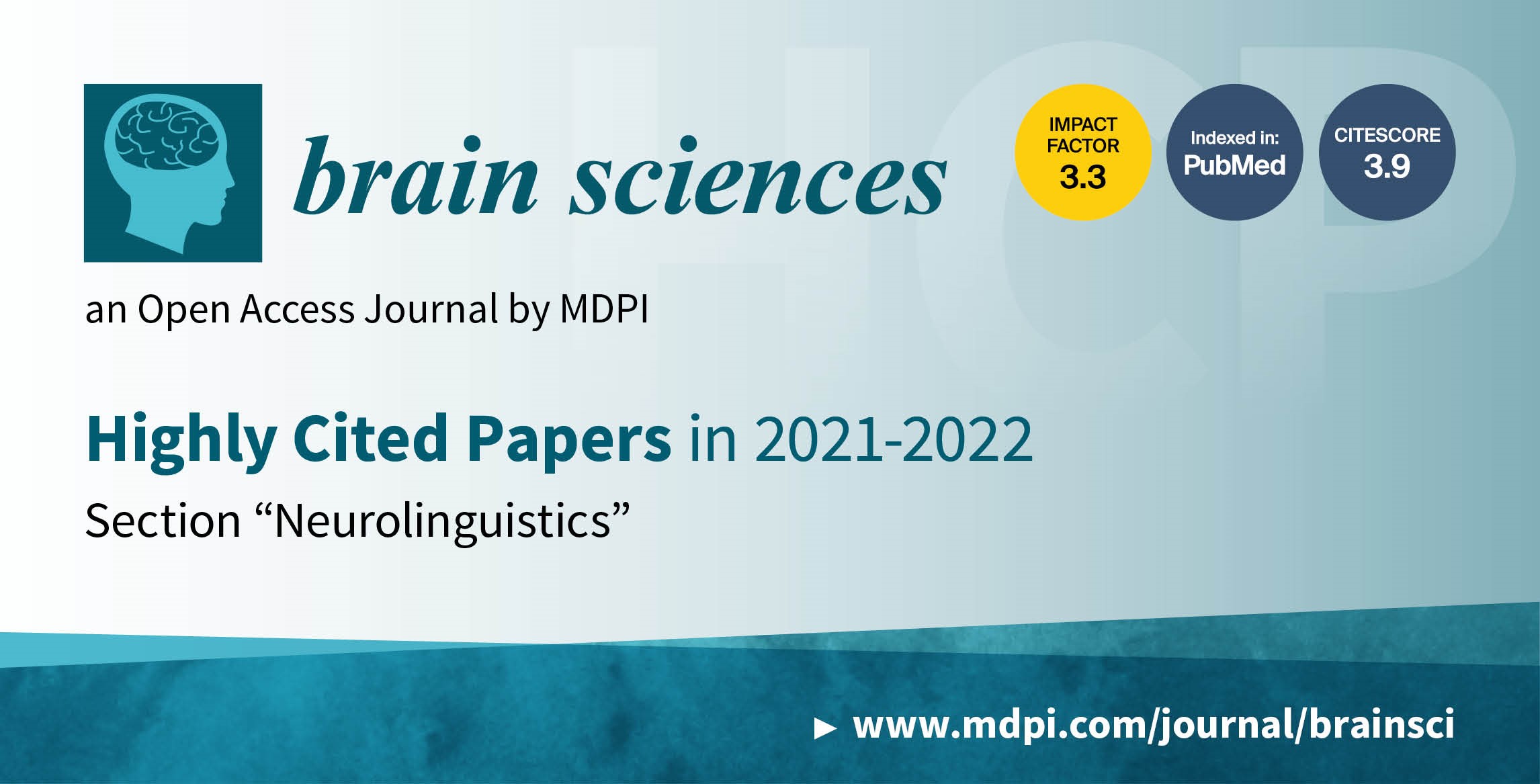Need Help?
4 August 2023
Brain Sciences | Highly Cited Papers from 2021–2022 in the Section “Neurolinguistics”

Neurolinguistics is the study of how the brain perceives, processes, and produces language. It is the study of the neural underpinnings and mechanisms that support our ability to perceive, produce, and understand words and sentences and learn our first, second, and subsequent languages, whose damage can result in disorders of speech, language, and reading.
As all the articles published in our journal are of an open access format, you have free and unlimited access to the full texts. We welcome you to read our most highly cited papers published in 2021 and 2022 listed below:
1. “Developmental Language Disorder: Early Predictors, Age for the Diagnosis, and Diagnostic Tools. A Scoping Review”
by Alessandra Sansavini, Maria Elena Favilla, Maria Teresa Guasti, Andrea Marini, Stefania Millepiedi, Maria Valeria Di Martino, Simona Vecchi, Nadia Battajon, Laura Bertolo, Olga Capirci et al.
Brain Sci. 2021, 11(5), 654; https://doi.org/10.3390/brainsci11050654
Available online: https://www.mdpi.com/2076-3425/11/5/654
2. “Efficacy of the Treatment of Developmental Language Disorder: A Systematic Review”
by Sara Rinaldi, Maria Cristina Caselli, Valentina Cofelice, Simonetta D’Amico, Anna Giulia De Cagno, Giuseppina Della Corte, Maria Valeria Di Martino, Brigida Di Costanzo, Maria Chiara Levorato, Roberta Penge et al.
Brain Sci. 2021, 11(3), 407; https://doi.org/10.3390/brainsci11030407
Available online: https://www.mdpi.com/2076-3425/11/3/407
3. “Adjunctive Approaches to Aphasia Rehabilitation: A Review on Efficacy and Safety”
by Chiara Picano, Agnese Quadrini, Francesca Pisano and Paola Marangolo
Brain Sci. 2021, 11(1), 41; https://doi.org/10.3390/brainsci11010041
Available online: https://www.mdpi.com/2076-3425/11/1/41
4. “Development of the Mechanisms Underlying Audiovisual Speech Perception Benefit”
by Kaylah Lalonde and Lynne A. Werner
Brain Sci. 2021, 11(1), 49; https://doi.org/10.3390/brainsci11010049
Available online: https://www.mdpi.com/2076-3425/11/1/49
5. “Creating a Theoretical Framework to Underpin Discourse Assessment and Intervention in Aphasia”
by Lucy Dipper, Jane Marshall, Mary Boyle, Deborah Hersh, Nicola Botting and Madeline Cruice
Brain Sci. 2021, 11(2), 183; https://doi.org/10.3390/brainsci11020183
Available online: https://www.mdpi.com/2076-3425/11/2/183
6. “Main Concept, Sequencing, and Story Grammar Analyses of Cinderella Narratives in a Large Sample of Persons with Aphasia”
by Jessica D. Richardson, Sarah Grace Dalton, Kathryn J. Greenslade, Adam Jacks, Katarina L. Haley and Janet Adams
Brain Sci. 2021, 11(1), 110; https://doi.org/10.3390/brainsci11010110
Available online: https://www.mdpi.com/2076-3425/11/1/110
7. “Exploring Affective Priming Effect of Emotion-Label Words and Emotion-Laden Words: An Event-Related Potential Study”
by Chenggang Wu, Juan Zhang and Zhen Yuan
Brain Sci. 2021, 11(5), 553; https://doi.org/10.3390/brainsci11050553
Available online: https://www.mdpi.com/2076-3425/11/5/553
8. “Effects of tDCS on Sound Duration in Patients with Apraxia of Speech in Primary Progressive Aphasia”
by Charalambos Themistocleous, Kimberly Webster and Kyrana Tsapkini
Brain Sci. 2021, 11(3), 335; https://doi.org/10.3390/brainsci11030335
Available online: https://www.mdpi.com/2076-3425/11/3/335
9. “Predictions about the Cognitive Consequences of Language Switching on Executive Functioning Inspired by the Adaptive Control Hypothesis Fail More Often than Not”
by Kenneth R. Paap, Lauren Mason and Regina Anders-Jefferson
Brain Sci. 2021, 11(9), 1217; https://doi.org/10.3390/brainsci11091217
Available online: https://www.mdpi.com/2076-3425/11/9/1217
10. “Perceptual Connectivity Influences Toddlers’ Attention to Known Objects and Subsequent Label Processing”
by Ryan E. Peters, Justin B. Kueser and Arielle Borovsky
Brain Sci. 2021, 11(2), 163; https://doi.org/10.3390/brainsci11020163
Available online: https://www.mdpi.com/2076-3425/11/2/163
11. “The Role of Audiovisual Speech in Fast-Mapping and Novel Word Retention in Monolingual and Bilingual 24-Month-Olds”
by Drew Weatherhead, Maria M. Arredondo, Loreto Nácar Garcia and Janet F. Werker
Brain Sci. 2021, 11(1), 114; https://doi.org/10.3390/brainsci11010114
Available online: https://www.mdpi.com/2076-3425/11/1/114
12. “A Network Analysis of the Relationship among Reading, Spelling and Maths Skills”
by Pierluigi Zoccolotti, Paola Angelelli, Chiara Valeria Marinelli and Daniele Luigi Romano
Brain Sci. 2021, 11(5), 656; https://doi.org/10.3390/brainsci11050656
Available online: https://www.mdpi.com/2076-3425/11/5/656
13. “Verbal Short-Term Memory Disturbance in the Primary Progressive Aphasias: Challenges and Distinctions in a Clinical Setting”
by David Foxe, Sau Chi Cheung, Nicholas J. Cordato, James R. Burrell, Rebekah M. Ahmed, Cathleen Taylor-Rubin, Muireann Irish and Olivier Piguet
Brain Sci. 2021, 11(8), 1060; https://doi.org/10.3390/brainsci11081060
Available online: https://www.mdpi.com/2076-3425/11/8/1060
14. “Breakdowns in Informativeness of Naturalistic Speech Production in Primary Progressive Aphasia”
by Jeanne Gallée, Claire Cordella, Evelina Fedorenko, Daisy Hochberg, Alexandra Touroutoglou, Megan Quimby and Bradford C. Dickerson
Brain Sci. 2021, 11(2), 130; https://doi.org/10.3390/brainsci11020130
Available online: https://www.mdpi.com/2076-3425/11/2/130
15. “Survival in the Three Common Variants of Primary Progressive Aphasia: A Retrospective Study in a Tertiary Memory Clinic”
by Maud Tastevin, Monica Lavoie, Justine de la Sablonnière, Julie Carrier-Auclair and Robert Laforce, Jr.
Brain Sci. 2021, 11(9), 1113; https://doi.org/10.3390/brainsci11091113
Available online: https://www.mdpi.com/2076-3425/11/9/1113
16. “Is There a Causal Link between the Left Lateralization of Language and Other Brain Asymmetries? A Review of Data Gathered in Patients with Focal Brain Lesions”
by Guido Gainotti
Brain Sci. 2021, 11(9), 1113; https://doi.org/10.3390/brainsci11091113
Available online: https://www.mdpi.com/2076-3425/11/9/1113
17. “Family-Based Whole-Exome Analysis of Specific Language Impairment (SLI) Identifies Rare Variants in BUD13, a Component of the Retention and Splicing (RES) Complex”
by Erin M. Andres, Kathleen Kelsey Earnest, Cuncong Zhong, Mabel L. Rice and Muhammad Hashim Raza
Brain Sci. 2022, 12(1), 47; https://doi.org/10.3390/brainsci12010047
Available online: https://www.mdpi.com/2076-3425/12/1/47
18. “Sentence Recall in Latent and Anomic Aphasia: An Exploratory Study of Semantics and Syntax”
by Christos Salis, Nadine Martin and Laura Reinert
Brain Sci. 2021, 11(2), 230; https://doi.org/10.3390/brainsci11020230
Available online: https://www.mdpi.com/2076-3425/11/2/230
19. “Longitudinal Changes in Cognition, Behaviours, and Functional Abilities in the Three Main Variants of Primary Progressive Aphasia: A Literature Review”
by Justine de la Sablonnière, Maud Tastevin, Monica Lavoie and Robert Laforce, Jr.
Brain Sci. 2021, 11(9), 1209; https://doi.org/10.3390/brainsci11091209
Available online: https://www.mdpi.com/2076-3425/11/9/1209
20. “Hard to Say, Hard to Understand, Hard to Live”: Possible Associations between Neurologic Language Impairments and Suicide Risk”
by Alessandra Costanza, Andrea Amerio, Andrea Aguglia, Luca Magnani, Gianluca Serafini, Mario Amore, Roberto Merli, Julia Ambrosetti, Guido Bondolfi, Lisa Marzano et al.
Brain Sci. 2021, 11(12), 1594; https://doi.org/10.3390/brainsci11121594
Available online: https://www.mdpi.com/2076-3425/11/12/1594

